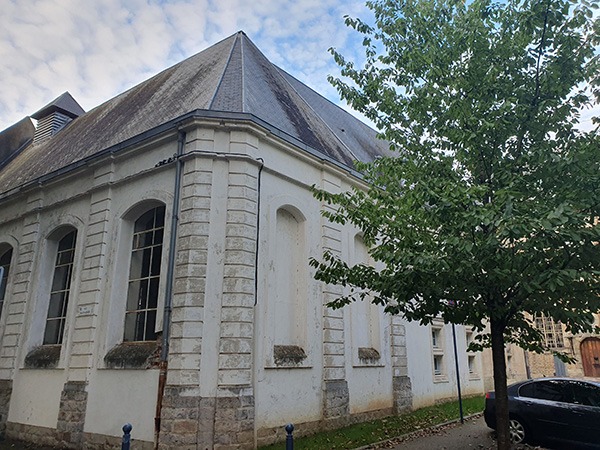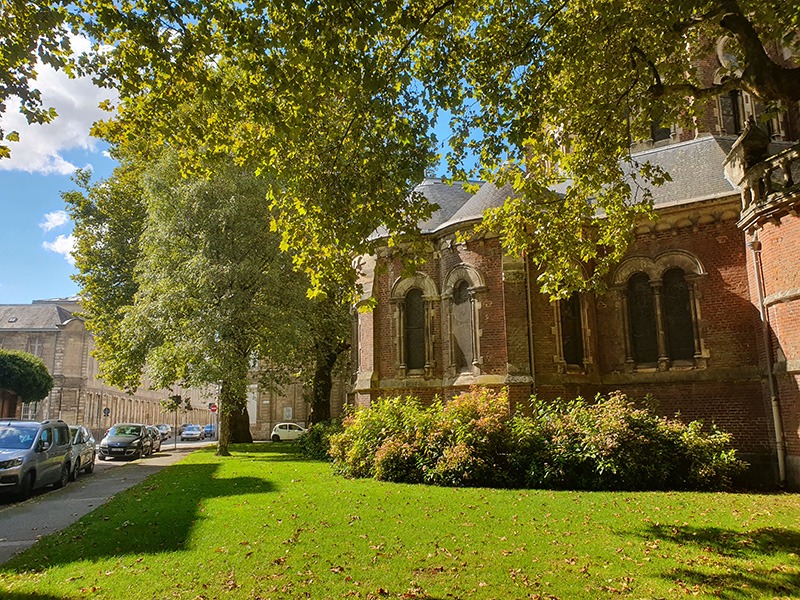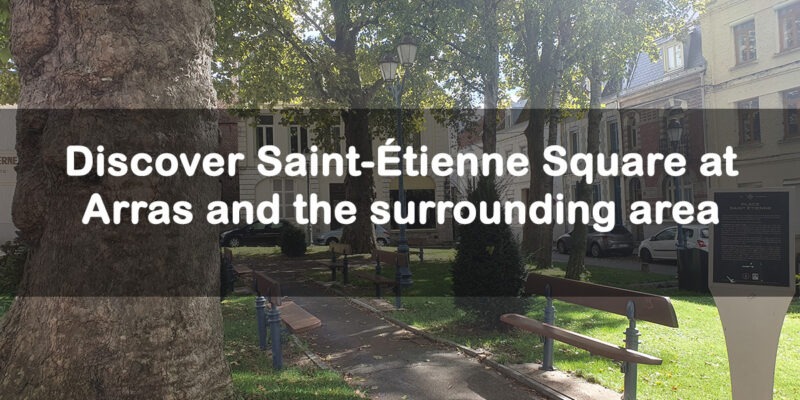Nestled in the historic center of Arras, Place Saint-Étienne is a place that breathes history with every stone.
This little corner of the city, often overlooked by visitors, is nevertheless home to some of Arras’ finest heritage treasures. To fully understand it, we need to go back in time, to the days when the ancient church of Saint-Étienne stood proudly on this site.
A square marked by the former Saint-Étienne church
Today, Place Saint-Étienne stands on the site of an ancient church whose construction dates back to the 11th century, a time when religious architecture was booming in Arras. Built around the year 1000, this place of worship has stood the test of time, becoming a symbol of spirituality and the importance of religion in the daily lives of its inhabitants. For several hundred years, Saint-Étienne church was a gathering point for the community, witness to the great events of Arrage’s history. But all that changed at the end of the 18th century. In 1790, at the height of the French Revolution, a time when the State was reappropriating ecclesiastical property, the building was transformed into the Friends of the Constitution Club, hosting political meetings and debates in a climate of revolutionary effervescence. However, this temporary use lasted only a few years.
In 1792, in the wake of the Revolution, the church was sold as national property and demolished shortly afterwards, marking the disappearance of an important part of Arras’ religious heritage. The demolition symbolized not only the break with France’s clerical past, but also the desire to redefine public spaces. Yet the sacred aura of the site seems to endure to this day. The stones of Place Saint-Étienne continue to whisper the story of the former church, and as you stroll through the square, you can still feel the imprint of the spirituality that has marked this place for nearly eight centuries.
Location:
The Convent of Saint Agnes : A 17th-century legacy
Around Place Saint-Étienne, a number of buildings bear witness to the area’s importance over the centuries. One of the most remarkable is undoubtedly the convent of Sainte-Agnès, founded in 1643 in a building that the monks of Saint-Vaast had dedicated to charitable works. Occupied by a community of thirteen women, this “Maison de Sainte-Agnès” was responsible for feeding, caring for and educating young orphans, thus continuing an important social work in the town.
During the French Revolution, the convent was transformed into a municipal establishment, but some of its buildings have survived to the present day. In particular, the chapel built in 1700, with its facade overlooking Rue Sainte-Agnès and its campanile, has been classified as a Historic Monument. Today, these features bear witness to the district’s rich religious and charitable past. They also recall the architectural style of the 17th century, giving the square and its surroundings an atmosphere steeped in history.

Convent of Saint Agnes
Notre-Dame des Ardents church : A symbol of perseverance
Just a stone’s throw from Place Saint-Étienne stands another emblematic building of Arrage’s heritage:Notre-Dame des Ardents church. This building, steeped in history, was built on the former Arsenal site, demonstrating the town’s ability to reinvent itself while preserving its traditions. The origins of the church go back to the initiative of Monseigneur Lequette, Bishop of Arras from 1866 to 1882, who wished to erect a dignified place of worship to house the reliquary of the Holy Candle. This project followed the destruction of the Petite Place chapel in 1791, an event that left the town without a place of worship dedicated to this sacred relic. Architect Clovis Normand, renowned for his neo-Romanesque style, was commissioned to design this brick and stone church. The work was carried out between 1869 and 1876, thanks to a public subscription launched among the inhabitants of Arras, demonstrating their commitment to the preservation of their religious heritage.
What makes Notre-Dame des Ardents particularly remarkable is its ability to stand the test of time, including the massive destruction caused by the Great War. Indeed, it is the only church in the center of Arras to have been spared the bombardments, giving it a powerful symbolic dimension. Its silhouette, proudly standing out in the urban landscape, is a reminder of the city’s religious fervour and the perseverance of the people of Arras in the face of the tragedies of history. Every stone in the church seems to tell the story of this resilience, inviting visitors to ponder the power of heritage and a town’s attachment to its spiritual roots.

Rear view of Notre-Dame des Ardents
An Arras district full of charm and memory
A stroll around Place Saint-Étienne takes you deep into the history of Arras. Every building, every street, seems to whisper tales of the past. The area, less crowded than the main squares, offers a peaceful atmosphere conducive to contemplation. The cobblestone streets, ancient facades and preserved buildings give the area a unique character, far removed from the hustle and bustle of the city center. As you explore Place Saint-Étienne and the surrounding area, you can’t help but be struck by the richness of this discreet heritage. Between the remains of the former convent of Sainte-Agnès, the preserved elegance of the Notre-Dame des Ardents church and the reminders of the former Saint-Étienne church, this district is an invitation to reflection and discovery. This is the magic of Arras: a city that, behind its famous facades and squares, hides unsuspected treasures for those who take the time to explore them.
R.C.
